About us
About Us
Who we are
We are a small, informal grassroots conservation group dedicated to the conservation of amphibians and reptiles in Bedfordshire. We are affiliated to the Bedfordshire Natural History Society, we are also members of the Beds Heathland Forum. In the past, we have helped draft Species Action Plans (SAPS) for both Bedfordshire Adders and Great Crested Newt. We are also affiliated with the Amphibian and Reptile Groups UK (ARG UK), the organisation that helps with coordinating regional ARGs.
Membership
We welcome both people who prefer to work as individuals, and people who prefer to work in cooperation with others through the Group. We occasionally organise outings and training sessions, for our members. These include such activities as workshops, particularly for people who wish to qualify for a GCN license. It doesn't matter if you've never surveyed for a newt or a lizard before, we'll be able to help train you and pair you up with someone to help generate data in your local area. At present membership is free, all you need to do to become a member is contact us.
Current members can log into the BedsRAG ARGWEB using the button below.
Our aims
At present, much of our activity has been concentrated on specific sites in the south of the county. We are only too aware of how little we know about North Bedfordshire. Bedfordshire is richer in herps than one might expect, our aim to try to map as much as this diversity as possible, through the use of targetted surveys and casual observations. If you spot any amphibians or reptiles in Bedfordshire, please report them using the appropriate tab above. Much of Bedfordshire is very poorly surveyed for amphibians and reptiles, we simply do not know what is there. Parts of the county are under severe development pressure and we hope to get a good picture of what is there before it is too late. If are interested in joining the group, and surveying you local patch for either amphibians or reptiles, please get in touch.
As well as the common species, we are also aware of two introduced species: midwife toads and marsh frogs, with one re-introduction: natterjack toads.
News
News
Habitat restoration work 2022
As dormant as the group may have seemed while it is reconfigured ,this is not the case.
As well as some members still continuing to carry out surveys and record species presence across the county a few other jobs have still been going on by individuals in the background.
Continued habitat maintenance and restoration is a key factor on many sites that can often be left by the wayside due to many factors , usually due to a lack in manpower and funds.
We hope to assist in this once again across the county now that Bedfordshire Reptile and Amphibian Group is reforming .
In the images below we can see work carried out to restore old brush piles that have deteriorated over time and started to rot down by some of our members on behalf of The Greensand Trust.
These brush piles create habitats for many species of not only reptiles and amphibians ,but also of small birds ,mammals ,insects ,plants and fungi.
For this project fallen trees and branches from the site were used to add new structure to the piles as well and some broom which grows extremely fast on some sites taking over and needing constant control , making use of what is already readily available on the site without the need to bring anything in from elsewhere ( which poses not only a biosecurity risk but also a lot of unnecessary logistics ) .
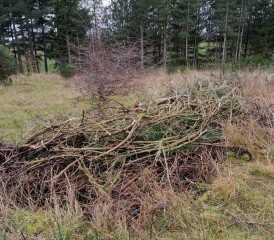
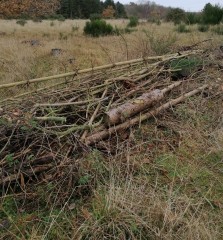
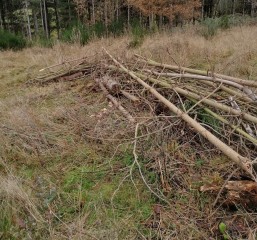
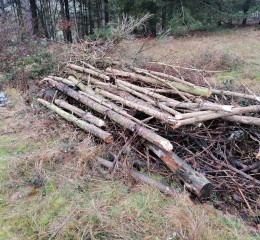
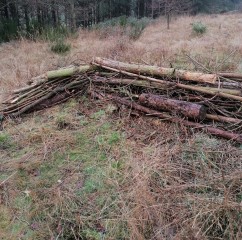
Meeting to discuss the future of BRAG Thursday 12 March
We will be holding a meeting at the Greensand Trust in Maulden at 19:30h on 12th March. If you would like to attend please contact us for details.
Great Crested Newts: colonisation of new ponds
It is usually said that GCN do not colonise new ponds quickly. We found an exception to this rule a couple of weeks ago. Three new ponds were excavated at Marston Thrift LNR in late February this year as part of the SITA / Natura International Marston Vale Great Crested Newt Project (see news item dated 20 February 2014). As they are so new these ponds have very little vegetation but when we surveyed them on 2nd June we found GCN eggs in one of the ponds! A clump of Yorkshire Fog grass had been thrown in and the newts were using this for egg laying. [See Photo Gallery]
Adders on Mark Avery’s blog
Nicholas Milton has written another piece on adders, this time as a guest on Mark Avery’s blog (for Nicholas’ previous article see our news item ‘Adders in the news’ of 24th March below). It is again well worth reading as are the comments, including one from BRAG member Matt Andrews.
http://markavery.info/2014/04/23/guest-blog-adders-buzzards-nicholas-milton/
Toad spawn and tadpoles
On 23 April last year we saw spectacular quantities of Common Toad spawn in a balancing pond near Marston Thrift LNR. Some balancing ponds, dug for a new development at Cranfield, contained little suitable vegetation for the Common Toads to lay their eggs on. Three clumps of vegetation, though, were favoured by the toads with the results you can see here [Photo Gallery]. The eggs are still round and have not developed far. This year we visited the same pond on 10 April and there were large numbers of tadpoles swimming about in the pond. What a difference in the timing!
Identification
Identification
Bedfordshire is home to a number of amphibian and reptile species, these may be hard to differentiate to the untrained eye. We've therefore provided the following information to help ensure that species identifications are correct, especially when it comes to recording. The links provided before should help most people when it comes to establishing the identity of an amphibian or reptile. If you're still stuck, then please feel free to contact us.
Amphibians
Amphibians tend to be found in close proximity to water, especially in the spring, although they may be found in terrestrial environments in the summer and autumn. This can sometimes lead to confusion between newts and lizards.
The following amphibians can be found in Bedfordshire:
- Common frog (Rana temporaria)
- Common toad (Bufo bufo)
- Natterjack toad (Epidalea calamita) - REINTRODUCED
- Smooth newt (Lissotriton vulgaris)
- Great crested newt (Triturus cristatus)
- Midwife toad (Alytes obstetricans) - INTRODUCED
- Marsh frog (Pelophylax ridibundus) - INTRODUCED
As far as we're aware, there are no populations of palmate newts, which tend to prefer more upland and acidic sites.
If you're unable to tell which amphibian species you've found, or you're dealing with a young individual, then we recommend this helpful guide from ARG UK.
Reptiles
Reptiles tend to be found in drier habitats than amphibians, they posses scales, and are also more agile than amphibians. Like amphibians, they hibernate throughout the winter months, and emerge again in the spring.
The following reptiles can be found in Bedfordshire:
- Adder (Vipera berus)
- Common (or viviparous) lizard (Zootoca vivipara)
- Grass snake (Natrix helvetica)
- Slow-worm (Anguis fragilis)
If you're unable to tell which reptile species you've found, then we recommend this helpful guide from ARG UK.
Photo gallery
Photo Gallery
Contact us
Contact Us
Dave Willis (Chair)
Upcoming Events
Upcoming events will be listed here.
Latest News
- Forest of Marston Vale site surveys
02/04/2023 10:21 am - Whipsnade Zoo Pond Surveys 14/04/22
16/04/2022 7:59 pm - Clophill Lakes torchlight site survey 18/03/22
19/03/2022 8:17 pm - First reformed BedsRAG field survey by torchlight!
13/03/2022 6:55 pm - A successful AGM 2022
25/01/2022 8:57 pm
© Bedfordshire Reptile & Amphibian Group (BedsRAG)
Website hits: 55915
View All | Find out how to get a mini-website for your ARG
© ARG UK Local Groups mini-websites 2025
Wind powered websites by Aye-aye Design.
